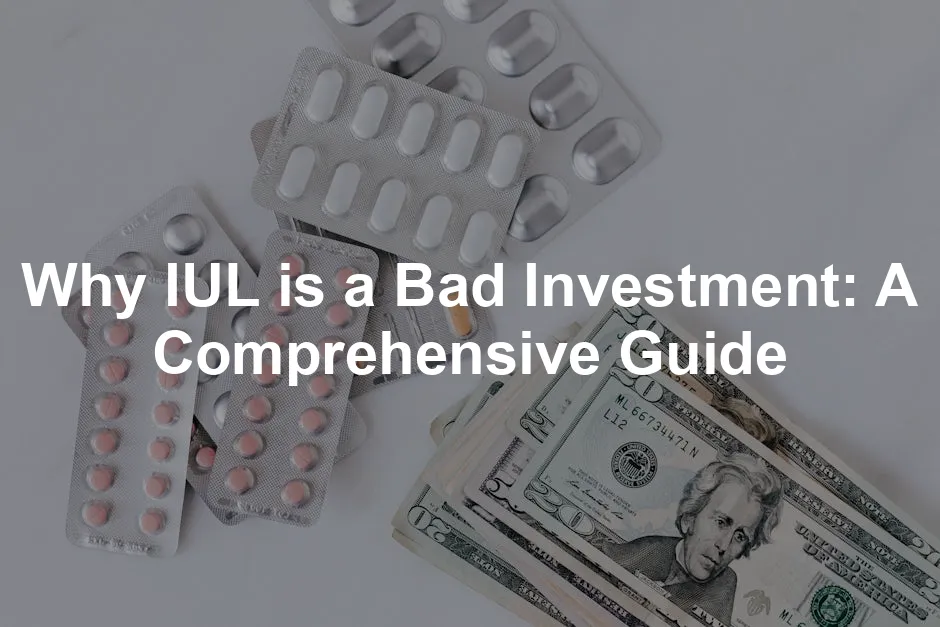
Why IUL is a Bad Investment: A Comprehensive Guide
Introduction
Indexed Universal Life (IUL) insurance often looks like a shiny new toy in the investment world. With promises of market-like returns and the safety net of life insurance, it’s no wonder folks are drawn to it. But let’s be real: sometimes that shiny toy is just a cleverly disguised lump of coal.
Imagine walking into a car dealership, eyeing a flashy sports car. The salesperson tells you it’s a “great investment” because it’ll appreciate in value—only to find out later that it’s a lemon that’ll cost you more in repairs than what you paid for it. This is the confusion many experience with IULs. What starts as “the next best thing” often devolves into “what was I thinking?”
This article aims to untangle the web of IULs and explore why they’re often considered poor investment choices. From hidden fees to complicated structures, we’ll shine a light on the pitfalls of this product, helping you understand its implications on your financial future. So, buckle up; it’s going to be an enlightening ride!

Summary of Key Points
IULs may seem appealing, but they come with a host of drawbacks. Here’s a quick rundown of the main arguments against them:
- Hidden Fees: What costs lurk beneath the surface?
- Limited Growth Potential: How do IUL returns stack up against traditional investments?
- Misleading Sales Practices: Why might agents misrepresent what IULs can do for you?
Curious about the details? Let’s dive deeper into these concerns and uncover the truth behind IULs.

Reasons Why IUL is a Bad Investment
High Fees and Costs
Overview of Fees
IULs come with a buffet of fees that can make your head spin. First up, we have administrative fees, which are like the cover charge at a fancy restaurant—an upfront cost for the privilege of being there. Next, there’s the cost of insurance, which increases as you age. Picture it as a surprise tip that keeps growing.
And don’t forget about surrender charges! If you decide to bail on your IUL early, you might get hit with a hefty fee. It’s like trying to leave a party after only an hour—good luck getting your deposit back! These fees can pile up faster than you can say “cash value,” seriously eroding your returns over time.
To avoid such pitfalls, consider reading The Total Money Makeover by Dave Ramsey. This book can help you build a solid financial foundation, preventing you from falling into traps set by high-fee products.

Impact on Returns
Let’s break it down with a little math magic. Imagine you invest $100,000 in an IUL. With all those pesky fees, you might only see a return of about 3% per year. Meanwhile, a traditional index fund could potentially yield 7% or more, especially with the power of compounding.
Over a decade, those fees could cost you tens of thousands of dollars. So, while you’re waiting for your IUL to mature, your money is busy taking a vacation, thanks to those fees. The bottom line? High costs can turn your seemingly safe investment into a financial black hole.
Limited Growth Potential
Caps and Participation Rates
IULs come with caps on returns, meaning even if the market does a happy dance, your gains are limited. Typically, these caps range from 10% to 15%, which is a far cry from the potential of the stock market. It’s like being promised a slice of cake but getting just a crumb!
Participation rates add another layer of complexity. If your policy has a participation rate of 80%, and the market gains 10%, you only get credit for 8%. That’s just a fancy way of saying your investment is on a strict diet! So, while the market is thriving, your returns might be stuck in a time warp.
Comparison to Traditional Investments
When you stack IULs against traditional investments, the underperformance becomes glaringly obvious. Studies show that over the long haul, index funds can yield returns that significantly outpace IUL policies. For example, over a 30-year period, the average annual return for an S&P 500 index fund has been around 10%, compared to the 2% to 5% range for IULs.
In other words, if you want your money to grow and play in the big leagues, IULs might not be your best bet. Instead, consider traditional investment options that offer transparency and fewer fees. After all, your financial future deserves a fighting chance, not a constrained journey on a merry-go-round.
For more insights on effective investing strategies, consider reading The Intelligent Investor by Benjamin Graham. It’s a classic that can guide you towards better investment choices.

Complexity and Lack of Transparency
Complex Structures
Indexed Universal Life (IUL) policies are like a Rubik’s Cube with missing stickers. They come packed with intricate details that can easily baffle even the most astute buyers. The cash value component, tied to stock market indices, sounds straightforward, right? Wrong! There are participation rates, caps, and fees lurking in the shadows. Each of these elements plays a role in your potential returns, but understanding how they interact can feel like trying to decipher ancient hieroglyphics. Many people enter the world of IULs with grand expectations but find themselves lost in a maze of jargon and fine print. This complexity can lead to poor financial decisions, as buyers often miss the fine details that ultimately dictate their returns.

Consumer Protection Issues
Compared to other financial products, IULs enjoy a surprising lack of regulation and oversight. While your average mutual fund must play by strict rules, IULs operate in a more nebulous environment. This can leave consumers vulnerable to misleading sales tactics and unqualified advice. Insurance agents, equipped only with state licenses, can present these policies as investment opportunities without the same scrutiny faced by registered financial advisors. The result? A perfect storm of confusion and misinformation that can leave consumers feeling like they were sold a bill of goods.
Misleading Sales Practices
Common Sales Tactics
Sales tactics surrounding IULs can feel like a carnival sideshow—flashy, enticing, but ultimately deceptive. Agents might paint a rosy picture of potential returns, often exaggerating the benefits while glossing over the complexities and costs. They may tout high growth potential, but fail to mention the caps on returns that can leave you feeling shortchanged. It’s as if they’re selling you a ticket to a game but neglecting to mention that you can’t win! This kind of misleading representation can lure in unsuspecting buyers, only for them to discover the reality is far less glamorous.
If you want to avoid being tricked, consider getting your finances in order with Rich Dad Poor Dad by Robert Kiyosaki. This book offers valuable lessons on financial literacy that can help you navigate the investment landscape.

Cherry-Picking Data
One of the most common missteps in IUL marketing is the selective presentation of data. Agents often showcase historical performance during favorable periods, conveniently ignoring the less flattering years. This cherry-picking makes IULs appear more appealing than they are in reality. It’s akin to showing off your high school basketball highlights while neglecting to mention that you barely made the team! By focusing on the best-case scenarios, agents can create unrealistic expectations that lead clients down a path of disappointment.
The Myth of Infinite Banking
Overview of the Concept
The “infinite banking” concept suggests that you can use IULs to build your wealth while borrowing against the cash value. Sounds too good to be true, right? Proponents claim this approach allows you to be your own banker, gaining access to your cash value without the traditional loan hassles. However, before you jump on this bandwagon, it’s crucial to examine the reality behind the allure.
Reality Check
While the idea of infinite banking may sound enticing, it comes with its own set of risks and costs. In practice, borrowing against your IUL can lead to reduced cash value and potential policy lapses if not managed properly. Additionally, interest on loans can chip away at your returns, making this strategy less appealing than it seems. Ultimately, the costs involved can undermine the very benefits that infinite banking purports to offer. So, while the dream of becoming your own bank might tickle your fancy, remember that the road is paved with hidden fees and potential pitfalls.

Real-Life Implications of Choosing IUL
Case Studies
Let’s meet Sarah, a well-intentioned individual who bought an Indexed Universal Life (IUL) policy thinking it was the golden ticket to wealth. She was promised the moon: tax-free growth, a death benefit, and lofty returns. Fast forward ten years, and what does Sarah have? A sinking feeling in her stomach and a cash value that barely scratches the surface of her expectations. “If I knew then what I know now,” she laments, “I would have invested in index funds instead.”
Sarah isn’t alone. Take Mike, a doctor who purchased three IUL policies, convinced of their benefits. After a decade, he found himself regretting the decision. “The fees have eaten away at my cash value,” he shared. “I could have done better with a simple retirement account.” These stories highlight a crucial lesson: IULs can lead to financial heartache, often leaving policyholders with regrets rather than riches.
The emotional toll of poor investment choices like IULs can be staggering. Imagine the stress of watching your cash value stagnate while your peers thrive with straightforward investments. It’s akin to being the only one at a party who brought a kale salad while everyone else is feasting on pizza. The feeling of isolation can be overwhelming, compounded by the realization that you’ve tied your future to a product that’s more smoke and mirrors than solid investment.
Speaking of investments, if you want to explore rental opportunities, consider The Book on Rental Property Investing by Brandon Turner. This guide can equip you with the knowledge to make smarter real estate decisions.

Alternatives to IUL
Now, let’s pivot to the alternatives. If IULs feel like a rollercoaster with too many twists and turns, perhaps it’s time to consider more stable rides. Traditional investments, such as index funds, offer transparency and lower fees. With an index fund, you get to ride the market without the pesky cap on gains. Historical data shows that index funds often outperform IULs over the long haul, making them a much more reliable choice for wealth building.
And what about retirement accounts? IRAs and 401(k)s shine bright in the investment arena. They provide tax benefits that IULs simply can’t match. Contributions to a traditional IRA may be tax-deductible, while Roth IRAs offer tax-free withdrawals in retirement. Plus, both accounts allow for straightforward growth potential without the puzzle of participation rates and caps.
In contrast to IULs, these alternatives provide clarity. You know exactly what you’re getting into—no hidden fees lurking in the shadows. So, if you’re weighing your options, consider these traditional vehicles. They might just lead you to the financial freedom you’re aiming for, without the emotional rollercoaster that comes with IULs.

Conclusion
It’s time to wrap things up and recap why Indexed Universal Life (IUL) insurance is often deemed a poor investment. First off, IULs are not the investment juggernauts they claim to be. Instead, they often resemble a confusing maze of fees and limitations. Let’s break down the major points we’ve covered.
Hidden fees are a significant red flag. Many policyholders are blindsided by administrative costs, insurance charges, and surrender fees. These can chip away at your cash value faster than you can say “unexpected expenses.” If you thought you were investing in a smooth ride to wealth, the reality is more like a bumpy road with surprise tolls.
Next, we have limited growth potential. The caps on returns restrict your gains, no matter how well the market performs. Imagine getting stuck with a tiny piece of cake while everyone else enjoys a full slice. Yes, your IUL might protect you from losses, but it also handcuffs your potential earnings.
Complexity is another beast. The intricate structure of IUL policies can leave even the savviest investors scratching their heads. This lack of transparency can lead to poor decisions and financial regret. It’s as if you’re trying to solve a puzzle without all the pieces.
Lastly, let’s not forget the misleading sales tactics often employed by agents. They might paint a picture of lucrative returns, but it’s crucial to read between the lines. The reality is that IULs are primarily life insurance products, not investment vehicles.
Before making any financial commitments, it’s essential to do your homework. Research thoroughly, and don’t hesitate to consult with a financial advisor who can help you navigate these waters.
In closing, separating your insurance needs from your investment strategy is vital. This ensures that you’re making informed, sound decisions that align with your financial goals. Your future self will thank you for it!

Frequently Asked Questions (FAQs)
Can you lose money in an IUL?
Yes, while IULs have a minimum interest floor, high fees can still lead to losses. If the fees outweigh the cash value growth, you may end up with less than you started.
What are the tax implications of IUL?
IULs offer tax-deferred growth, meaning you won’t pay taxes on the cash value growth until you withdraw it. However, this can be less favorable compared to traditional investment accounts like IRAs, which often provide clearer tax benefits.
Is there ever a good scenario for investing in an IUL?
In rare cases, high-net-worth individuals might use IULs for estate planning or as part of a diversified portfolio. However, for most people, traditional investments yield better returns and fewer complications.
How does an IUL compare to a Roth IRA?
IULs are complex insurance products, while Roth IRAs are straightforward retirement accounts. Roth IRAs offer tax-free growth and withdrawals, with no caps on earnings, making them generally more favorable for long-term growth.
What should I do if I currently own an IUL?
Evaluate your policy carefully. Consider consulting a fee-only financial advisor to assess your options and determine if it’s time to make adjustments or explore better alternatives.
Please let us know what you think about our content by leaving a comment down below!
Thank you for reading till here 🙂
For a deeper understanding of the pitfalls associated with Indexed Universal Life insurance, you can read more about why IUL is a bad investment.
All images from Pexels




